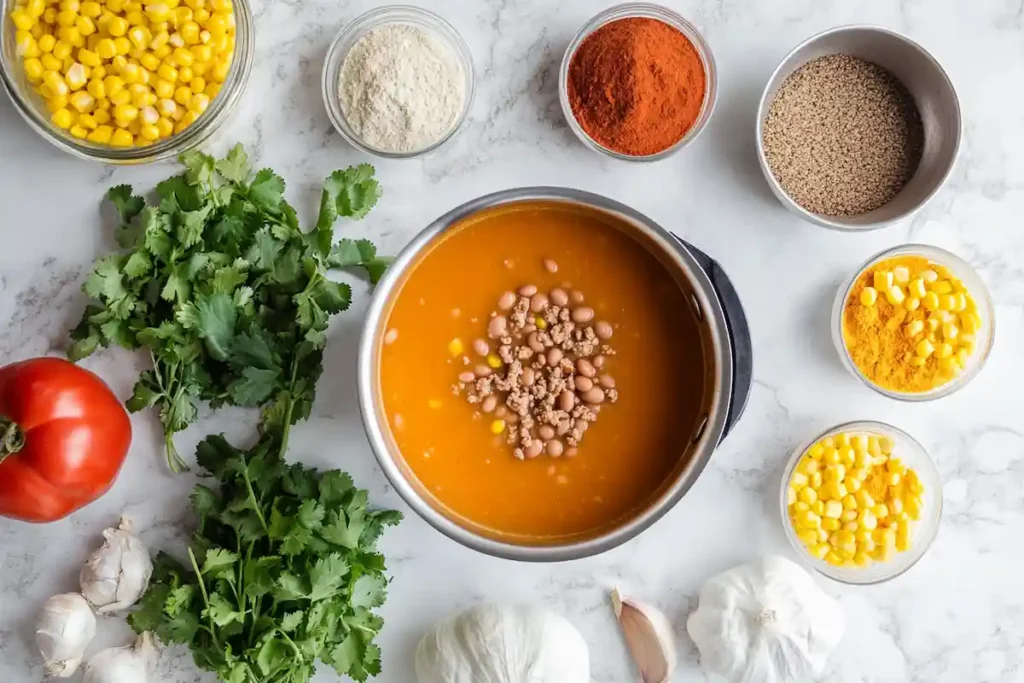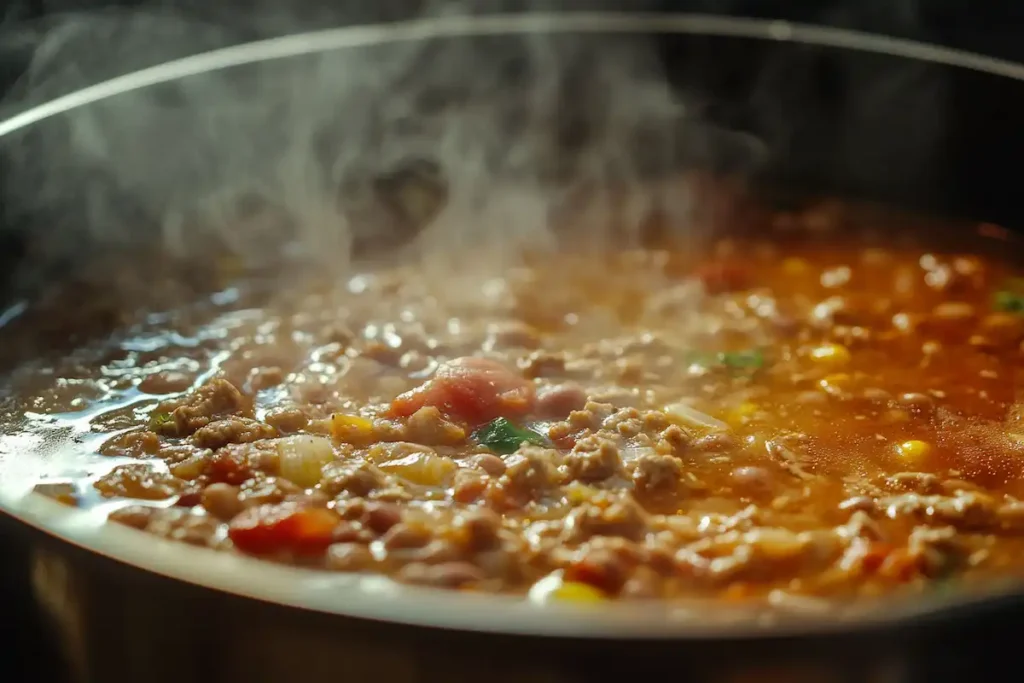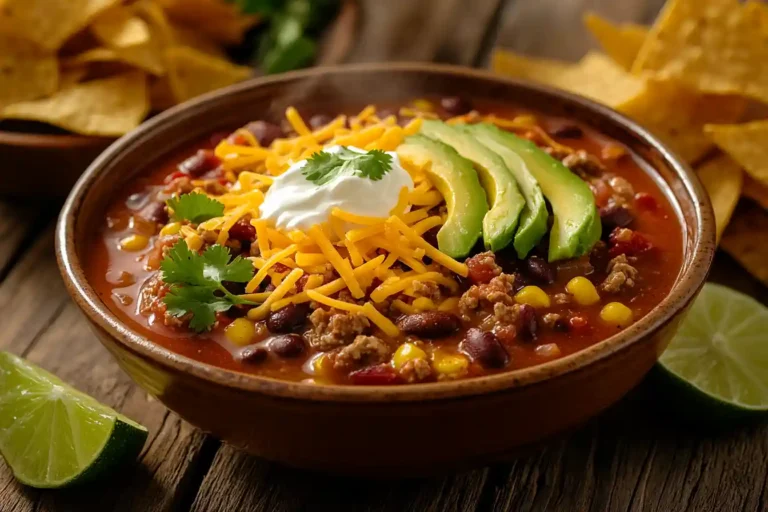Taco soup is a comforting, flavorful dish loved by many, but it can be disappointing when it turns out too watery. Whether you’re a novice or a seasoned cook, finding the perfect balance of texture and flavor can sometimes be tricky. In this article, we’ll explore the common reasons for watery taco soup, practical tips to fix it, and preventative measures to ensure a hearty, well-textured dish. Let’s dive into the details to make your taco soup a success every time!
1. Understanding Watery Taco Soup
What Does Watery Taco Soup Mean?
Watery taco soup lacks the thick, hearty consistency that many expect from this dish. Instead of a rich broth packed with flavors, you might end up with a soup that feels diluted or bland. The texture plays a big role in how satisfying the dish is, so getting it just right is key.
Common Causes of Watery Taco Soup
Using Too Much Liquid
One of the most common culprits is adding more liquid than the recipe calls for. Whether it’s broth, water, or juice from canned goods, too much liquid can overwhelm the other ingredients, leaving the soup runny and flavorless.
High Water Content in Ingredients
Fresh vegetables and canned ingredients often contain water, which can release into the soup as it cooks. Ingredients like tomatoes, onions, and corn can add unexpected moisture that throws off the balance.
Incorrect Liquid-to-Ingredient Ratios
Achieving the right ratio of liquid to solid ingredients is critical. If the soup has too few chunky components—like beans, meat, or vegetables—it can feel overly thin and unappetizing.
By understanding these root causes, you’ll be better prepared to address and avoid the issue. In the next section, we’ll explore why these mistakes happen and how to fix them. Ready to thicken things up? Let’s move on!
2. Key Reasons Your Taco Soup Is Watery

Mistakes in Recipe Proportions
A common reason for watery taco soup is simply getting the proportions wrong. When you’re adding broth, water, or canned liquids, it’s easy to overdo it. Recipes often call for specific measurements, but eyeballing it might lead to an overly liquidy consistency. Balancing the liquid-to-ingredient ratio is crucial for achieving that satisfying thickness.
To avoid this mistake, measure your ingredients carefully and consider the type of liquids used. Broth or stock has a richer consistency compared to plain water, so it’s better suited for soups. Additionally, be mindful of liquids from canned goods like diced tomatoes—these can add unexpected moisture.
Improper Cooking Techniques
Cooking technique is another big factor that can impact your soup’s texture. If you’re in a rush and don’t allow enough time for the soup to simmer, it won’t reduce properly, leaving it watery. Simmering lets excess water evaporate while intensifying the flavors.
On the flip side, overcooking ingredients like vegetables can cause them to release water into the soup. For example, tomatoes and onions are notorious for this. Timing and temperature control are key—maintaining a low simmer ensures gradual thickening without breaking down your ingredients.
For more taco soup ideas, check out What Can I Use to Thicken Taco Soup? for additional insights.
3. Effective Ways to Thicken Taco Soup
Adding Thickening Agents
When you’re looking to fix watery taco soup quickly, adding a thickening agent can save the day. A cornstarch slurry is one of the easiest and fastest fixes. Simply mix cornstarch with a small amount of cold water to make a paste, then stir it into the soup as it simmers. This method works best when added gradually, allowing you to control the consistency.
Another option is flour. While it’s slightly less potent than cornstarch, flour can add body to your soup. Mix it with butter or oil to make a roux before adding it to your soup to avoid clumps.
Using Natural Ingredients for Thickening
For a more natural approach, consider thickening with pureed vegetables or beans. These ingredients not only add texture but also enhance the flavor profile of your taco soup. Black beans or pinto beans can be blended and stirred into the soup, providing creaminess without additional fats or starches.
Cheese is another excellent choice, especially shredded cheddar or a Mexican blend. It melts beautifully into the soup, thickening it while adding a rich, cheesy taste. Tortilla chips can also work wonders—crush them and let them dissolve in the soup as it cooks.
Reduction Techniques
If you prefer not to add extra ingredients, reducing the soup naturally is a great option. Letting your soup simmer uncovered allows water to evaporate, thickening the consistency over time. This technique also intensifies the soup’s flavors, making it even more delicious.
To ensure consistent thickening, stir the soup occasionally and keep an eye on the heat. A slow simmer is best, as boiling can cause ingredients to break down too much.
For more inspiration on thickening your taco soup, check out Taco Soup Frios Recipe.
4. Preventing a Watery Soup in the Future
Pre-Cooking Preparation Tips
The best way to solve the problem of watery taco soup is to prevent it in the first place. Start by preparing your ingredients with care. Canned vegetables like tomatoes or corn often contain excess liquid. To minimize this, drain and rinse them thoroughly before adding them to your soup.
Another trick is to focus on your choice of fresh ingredients. Vegetables with high water content, such as zucchini or bell peppers, can release moisture while cooking. If you must include them, consider sautéing these vegetables first to remove excess water before incorporating them into the soup.
When working with meat, browning it before adding it to the soup can also help. This not only improves flavor but also ensures that any water released during cooking doesn’t dilute your soup.
Proper Storage and Reheating Techniques
Even if your taco soup starts out perfectly thick, improper storage and reheating can lead to a watery consistency. When refrigerating leftovers, store your soup in an airtight container. To avoid excess moisture forming, allow the soup to cool slightly before sealing.
When reheating, choose stovetop or microwave methods that let you stir frequently. If the soup becomes too thin during reheating, add a small amount of thickening agent, such as cornstarch or pureed beans, to restore its texture. By following these steps, you can keep your taco soup thick and delicious, even on the second day.
For more delicious ideas, explore our tips on What Can I Use to Thicken Taco Soup?.
5. Enhancing Flavor and Texture

How to Balance Flavors While Thickening
Achieving the perfect taco soup isn’t just about texture—it’s about flavor too! When adding thickening agents like cornstarch or cheese, always adjust your seasoning. A watery taco soup often tastes bland because the flavors are diluted. After thickening, add a dash of chili powder, cumin, or smoked paprika to enhance the flavor.
If your soup feels too salty or overly seasoned after adjustments, balance it with a squeeze of lime or a sprinkle of sugar. These small tweaks can elevate your soup from good to amazing.
Adding Toppings for Extra Flair
A bowl of taco soup is more than its base—it’s all about the toppings! To boost both texture and flavor, consider adding crunchy tortilla strips, shredded cheese, or a dollop of sour cream. Avocado slices or fresh cilantro can also provide a refreshing contrast to the soup’s richness.
For a truly memorable meal, pair your taco soup with warm cornbread or crispy quesadillas. These sides not only complement the soup but also help to round out the meal beautifully.
If you’re craving more hearty, comforting recipes, browse our collection of taco-inspired dishes for endless inspiration.
6. Creative Variations for Taco Soup
Adding a Twist to the Classic Recipe
Once you’ve mastered the art of thickening taco soup and answered Why is my taco soup so watery?, it’s time to experiment with creative variations. Incorporating unexpected ingredients can elevate your soup to the next level. Try adding roasted poblano peppers for a smoky depth or diced sweet potatoes for a hint of sweetness. These additions not only thicken the soup naturally but also introduce exciting new flavors.
Another twist is to switch up the protein. Ground turkey, shredded chicken, or even plant-based options like lentils or tofu can provide variety while maintaining the dish’s heartiness. Each ingredient brings its own texture, further enhancing the soup’s consistency.
Transforming Taco Soup into a Crowd-Pleaser
To make your taco soup a hit at gatherings, consider serving it as a dip. Reduce the liquid slightly and serve it with tortilla chips for a thicker, scoopable dish. Adding a dollop of guacamole or sour cream on top can make it even more indulgent.
For a layered taco soup experience, bake it in a casserole dish with cheese and tortilla chips layered between the soup. This approach transforms your taco soup into a unique, baked comfort food perfect for entertaining.
7. Troubleshooting Common Mistakes
Avoiding the Watery Soup Dilemma
If you find yourself asking, Why is my taco soup so watery? even after following the recipe, it might be due to subtle oversights. One common mistake is not draining canned vegetables properly. The liquid from these cans can sneak in, thinning your soup without you realizing it. Always drain and rinse to avoid this issue.
Another culprit is overcooking. Extended cooking times can break down vegetables, releasing excess water and compromising the texture. Keeping an eye on cooking times ensures your soup stays rich and satisfying.
Recovering from Errors
Sometimes, even the best efforts don’t prevent a watery soup. When this happens, quick fixes can save the day. Adding crushed tortilla chips, instant mashed potatoes, or a cornstarch slurry can thicken the soup in minutes. If the soup’s flavor is diluted, remember to adjust the seasoning to bring back its zest.
For additional tips on troubleshooting cooking challenges, explore helpful guides at Smarts Recipes.
8. Frequently Asked Questions (FAQs)
How to Fix Watery Taco Soup?
If you’re wondering, Why is my taco soup so watery?, the solution is often simpler than you think. Start by reducing the liquid through simmering. Keep the soup uncovered and stir occasionally to prevent sticking. Alternatively, add a thickening agent like cornstarch or flour. A small amount mixed with cold water can work wonders. Pureed beans or vegetables are also great for naturally thickening the soup while boosting its flavor.
How Do You Fix Soup That Is Too Watery?
To fix a watery soup of any kind, first determine the root cause. If it’s due to excess liquid, simmering uncovered is your best bet. For quicker fixes, adding a slurry made from cornstarch, flour, or even instant potato flakes can quickly thicken the soup. Remember to stir the mixture well to avoid clumps. If it’s still thin, try blending a portion of the soup to create a thicker base.
How to Thicken Taco Sauce?
Taco sauce can sometimes turn out thinner than expected. To thicken it, you can use similar methods as for soups: adding cornstarch, a roux, or reducing it on low heat. For an extra kick, blend in a spoonful of refried beans or tomato paste. These additions not only thicken the sauce but also enhance its flavor.
How to Thicken Mexican Tortilla Soup?
Mexican tortilla soup can be thickened using tortilla chips or masa harina (corn flour). Crush a handful of tortilla chips and stir them into the soup as it simmers. They will dissolve, adding a rich texture. Masa harina is another authentic option that thickens the soup while deepening its traditional flavor.
If you’re interested in more ideas, explore recipes that address common cooking challenges, like watery soups, at Smarts Recipes.
9. Conclusion and Final Tips
Bringing It All Together
Taco soup is a simple yet satisfying dish that thrives on balance. From understanding Why is my taco soup so watery? to applying tips for thickening, you’ve now got all the tools you need to master this comfort food. Whether it’s through careful ingredient preparation, proper cooking techniques, or creative use of thickening agents, you can ensure your taco soup turns out thick and flavorful every time.
Final Takeaways
The next time you face a watery taco soup, don’t stress. With solutions like simmering, using cornstarch, or blending beans, fixing it is quick and easy. And to prevent future mishaps, always measure your ingredients, drain canned goods, and store leftovers properly. Remember, a well-thickened soup not only looks better but tastes richer and more satisfying.
For more recipe inspiration and cooking tips, check out our collection of taco-inspired dishes at Smarts Recipes. Happy cooking!

